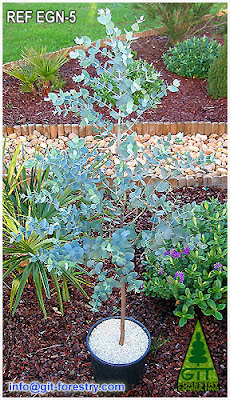Early growth in ornamental eucalypts: Sculpting Eucalyptus gunnii
Gustavo Iglesias Trabado
We have put together some images of ornamental Eucalyptus growing in our own garden and some explanatory texts on horticultural recommendations at each stage of cultivation during their early years in order to control their growth and form. Just click the images to enlarge them and follow the links under each figure for full description of each stage.
STEP 1: Get a good quality ornamental Eucalyptus plant
 Fig. 1: Standard potted ornamental eucalypt ready to be planted out
Fig. 1: Standard potted ornamental eucalypt ready to be planted out
Gustavo Iglesias Trabado

GIT Forestry Consulting - Consultoría y Servicios de Ingeniería Agroforestal - www.git-forestry.com - EUCALYPTOLOGICS
We have put together some images of ornamental Eucalyptus growing in our own garden and some explanatory texts on horticultural recommendations at each stage of cultivation during their early years in order to control their growth and form. Just click the images to enlarge them and follow the links under each figure for full description of each stage.
STEP 1: Get a good quality ornamental Eucalyptus plant
 Fig. 1: Standard potted ornamental eucalypt ready to be planted out
Fig. 1: Standard potted ornamental eucalypt ready to be planted outRead more on ornamental Eucalyptus in standard containers: add an Australian touch to your garden.
STEP 2: Plant your Eucalyptus and observe during the first year
Read more on early growth in garden Eucalyptus and how observing the progress of your tree will let you decide on when to start sculpting your big bonsai.
STEP 3: Keep your Eucalyptus bushy, size control via pollarding
Read more on size control operations in garden Eucalyptus to restrict height growth and encourage lateral branching.
STEP 4: Make your Eucalyptus compact, branch division via pruning
 Fig. 4: Second year early growth after size control operations (pruning & clipping)
Fig. 4: Second year early growth after size control operations (pruning & clipping)Read more on risk minimisation when pruning garden Eucalyptus. Time well your maintenance operations!
STEP 5: Observe Eucalyptus branch length growth and keep sculpting
STEP 5: Observe Eucalyptus branch length growth and keep sculpting
Benefits of combining pollarding, pruning and clipping on young ornamental garden Eucalyptus
- Size control achieved, important for gardens with limited space (tree size estabilised around 3 m)
- Basal branches retained (not discarded by the tree after building up higher crown)
- More compact form (noticeable length growth in basal branches)
- Balanced aerial part/root system ratio (we minimise windhtrow damage risks)
- Fresh Eucalyptus foliage harvest from pruning operations, useful for flower arrangements
Keep an eye on...
- New branch architecture after pruning: Not all Eucalyptus trees managed this way develop several main branches after pollarding. The pictured one shows how one of the lateral branches took apical dominance. We obtained good branching in other specimens.
- Leaning towards light: Development of new main branches can be achieved but they tend to grow towards the light. This is important if Eucalyptus are planted in partial shade. This effect can be somewhat controled using stakes and wire to train future main branches to the desired direction while they are yet flexible and not woody.
Time invested in maintenance during the first 65 weeks
- Planting: 1.5 hours
- Fertilising: 0.1 hours
- Pollarding: 0.1 hours
- Pruning: 0.1 hours
- Clipping: 1.5 hours
- Watering: 4.5 hours
Total: 8 hours
- Fertilising: 0.1 hours
- Pollarding: 0.1 hours
- Pruning: 0.1 hours
- Clipping: 1.5 hours
- Watering: 4.5 hours
Total: 8 hours
Want to know more?
Fill the contact form or explore GIT Forestry Consulting's main website and this blog!
 Subscribe to receive EUCALYPTOLOGICS via e-mail
Subscribe to receive EUCALYPTOLOGICS via e-mail
Fill the contact form or explore GIT Forestry Consulting's main website and this blog!
Subscribe to receive EUCALYPTOLOGICS via RSS
© 2007 Gustavo Iglesias Trabado. Please contact us if you want to use all or part of this text and photography elsewhere. We like to share, but we do not like rudeness.































0 Comments by our readers :::
Send a comment to EUCALYPTOLOGICS